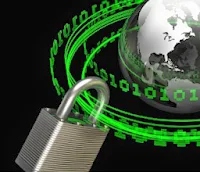The foundation of quantum cryptography lies in the Heisenberg Uncertainty principle, which states that certain pairs of physical properties are related in such a way that measuring one property prevents the observer from simultaneously knowing the value of the other, and the principle of photon polarization which tells that an eavesdropper cannot copy unknown qubits (quantum bits).
In particular, when measuring the polarization of a photon, the choice of what direction to measure affects all subsequent measurements. For instance, if one measures the polarization of a photon by noting that it passes through a vertically oriented filter, the photon emerges as vertically polarized regardless of its initial direction of polarization. If one places a second filter oriented at some angle q to the vertical, there is a certain probability that the photon will pass through the second filter as well, and this probability depends on the angle q. As q increases, the probability of the photon passing through the second filter decreases until it reaches 0 at q = 90 deg (i.e., the second filter is horizontal). When q = 45 deg, the chance of the photon passing through the second filter is precisely 1/2. This is the same result as a stream of randomly polarized photons impinging on the second filter, so the first filter is said to randomize the measurements of the second. The principle of photon polarization states that an eavesdropper cannot copy unknown qubits, due to a no-cloning theorem.
Unpolarized light enters a vertically aligned filter, which absorbs some of the light and polarizes the remainder in the vertical direction. A second filter tilted at some angle q absorbs some of the polarized light and transmits the rest, giving it a new polarization. A pair of orthogonal (perpendicular) polarization states used to describe the polarization of photons, such as horizontal/vertical, is referred to as a basis. A pair of bases are said to be conjugate bases if the measurement of the polarization in the first basis completely randomizes the measurement in the second basis, as in the above example with q = 45 deg. It is a fundamental consequence of the Heisenberg Uncertainty principle that such conjugate pairs of states must exist for a quantum system.
Quantum cryptography promises to revolutionize secure communication by providing security based on the fundamental laws of physics, instead of the current state of mathematical algorithms or computing technology.
So these topics are explained in Quantum Cryptography PPT and Seminar Report with illustrated images. If you want to download the Quantum Cryptography PPT and Seminar Report then simply click the link given below. There is also given the preview and link of Quantum Cryptography PPT uploaded on YouTube. All the images used are copyrighted to the owners of the respective websites mentioned in the Quantum Cryptography PPT Report reference slide.
Preview of Quantum Cryptography PPT


0 comments